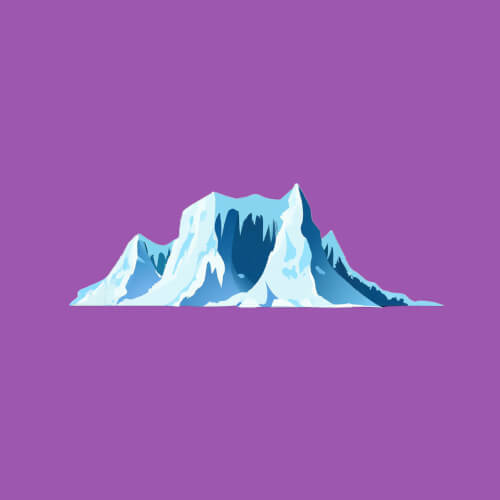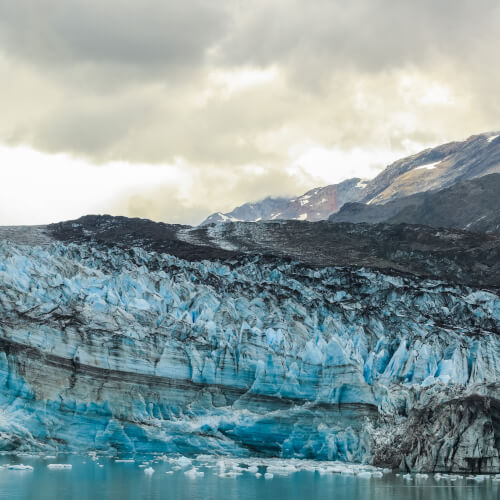



Glaciers are massive bodies of freshwater ice that form on land over long periods of time. They are found only in the coldest regions of the Earth, such as high mountains and polar regions, like Antarctica. Though they are often confused, glaciers are not the same as sea ice, which forms exclusively in and from ocean saltwater.
A glacier can be thought of as a sort of frozen river, made from compacted snow and ice. Though they might look like they're standing still, glaciers are in fact always slowly moving because of the force of gravity on their enormous mass. As they move, they often have great impact on the landscape around them.
Glaciers form in a process that takes many, many years. It starts with the accumulation of snow in an area where temperatures remains below freezing for most of the year. Over time, the weight of the accumulated snow compresses the layers beneath, turning the snow into ice. This process is called "compaction," and is kind of similar to the way sedimentary rocks are formed. As more and more snow accumulates and compacts, it forms a thick mass of ice, or glacier.
Glaciers may seem motionless, but they are actually always slowly on the move. The movement is due to the pressure exerted by the weight of the ice and gravity. As the ice at the bottom of the glacier melts, it creates a thin layer of water that acts as a lubricant, allowing the glacier to slide downhill. This movement can't be seen by the naked eye, since it can take years for the glacier to noticeably change its position.
Glaciers can have a huge impact on the landscape around them. As they move, they can carve out valleys and create distinct features on the land. This process, known as "glacial erosion," shapes the terrain, forming U-shaped valleys, cirques (bowl-shaped hollows), and jagged peaks. Glaciers also transport rocks and sediments, which can leave behind deposits as the ice melts. These deposits, called "glacial moraines," can be seen as mounds or ridges of rocks and soil.
Glaciers play a crucial role in maintaining the Earth's water cycle. They store large amounts of freshwater, which is released slowly over time. As the ice melts, it contributes to the flow of rivers and helps sustain ecosystems downstream. Glaciers also act as natural reservoirs, providing water for human consumption, agriculture, and hydropower generation.
Glaciers are vulnerable to the effects of climate change. Rising temperatures cause glaciers to melt at a faster rate than they can accumulate new ice. This imbalance leads to their retreat and shrinkage. As glaciers decline, it can disrupt water supplies, affect biodiversity, and contribute to sea-level rise, which has implications for coastal areas around the world.
Understanding glaciers and their changes is essential for studying climate patterns and the impact of human activities on the environment. Scientists continue to monitor and study glaciers to gain insights into the Earth's past climate and predict future changes.
Not actual mice, glacier mice are small clumps of moss that gather debris and dirt, creating a protective layer that insulates the underlying ice from sunlight. As a result, the ice beneath the moss melts at a slower rate compared to the surrounding glacier. This causes the moss balls to roll and move slowly, seemingly in a coordinated manner.
The movement of glacier mice is still not fully understood, but it is believed to be influenced by factors like wind, temperature gradients, and interactions with melting water. This phenomenon creates a fascinating sight, as these mossy balls seem to roam across the icy landscape, creating the illusion of a miniature creatures traveling around on the surface of the glacier.
One of the best examples is Ötzi the Iceman, the natural mummy of a man who lived around 5,300 years ago during the Copper Age. In 1991, hikers stumbled upon his remains in the Ötztal Alps on the border between Austria and Italy. Ötzi's body had been naturally preserved within a glacier for thousands of years.
The glacier acted as a protective layer, freezing and preserving Ötzi's body along with his clothing, tools, and other possessions. This remarkable find provided a rare glimpse into the life of an individual from the distant past. Scientists were able to study Ötzi's remains and gather information about his health, diet, clothing, and even the tools he used. It offered valuable insights into the living conditions, technologies, and customs of that time.
When glaciers move, they can produce a variety of sounds that range from gentle creaks and groans to loud, booming noises. These sounds are caused by the stress and pressure exerted on the ice as it flows and breaks. Additionally, as meltwater flows through crevasses, or cracks and tunnels within the glacier, it can create rushing or gurgling sounds.
Sometimes, under specific conditions, these glacial sounds can be amplified and resonate, creating haunting and ghostly melodies. The vibrations from the movements of the ice can travel through the surrounding landscape, producing a low-frequency hum that can be heard for kilometers.
While ice is naturally almost colorless, the dense ice in glaciers can absorb longer wavelengths of light, such as red and yellow, while reflecting shorter wavelengths, such as blue. This selective reflection of blue light give glaciers a stunning blue color. The intensity of the blue color can vary depending on factors like ice density, impurities, and lighting conditions.
Launched in October 2013 in Ladakh, India, the Ice Stupa Project, created by Sonam Wangchuk, involves using only gravity to freeze winter water into large cones of ice around 6 m (20 ft) tall. Ladakh receives only about 50 mm (2 in) of rain each year, and is dependent on glacial water—climate change has dramatically lowered the amount of glacial water. The Ice Stupa project has provided a way for Ladakh's otherwise unused winter water to stay frozen, to be used later in the year.
As snow accumulates and compresses into ice over time, air bubbles get trapped within the layers. These air bubbles can preserve samples of the Earth's atmosphere from thousands or even hundreds of thousands of years ago. Scientists can extract and analyze these air bubbles to learn about past climates and atmospheric conditions, providing valuable insights into our planet's history.